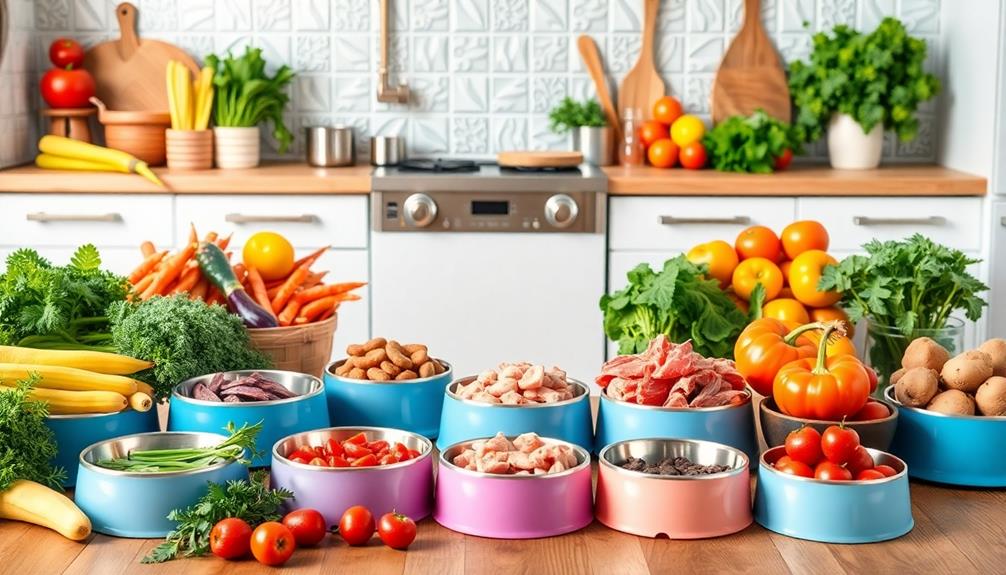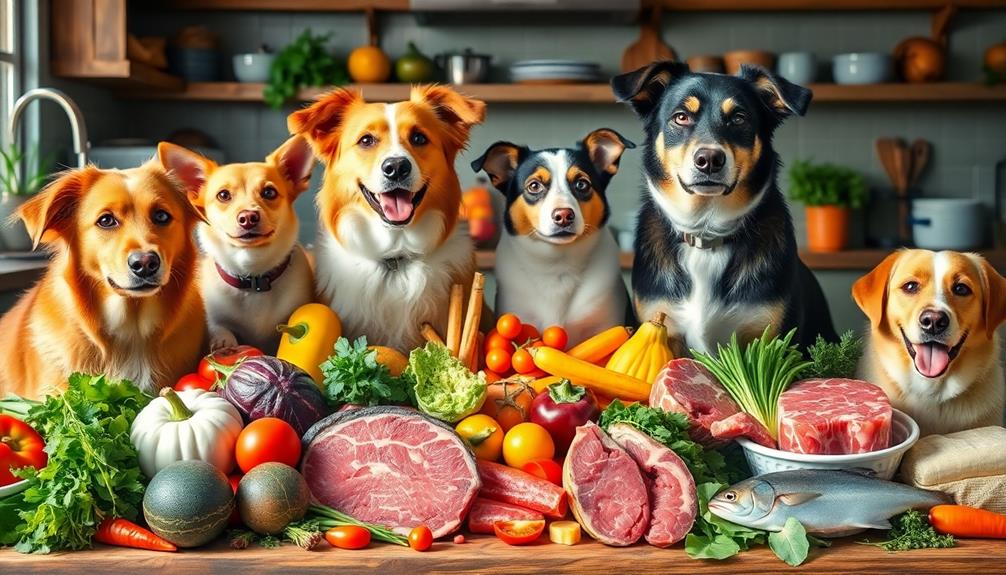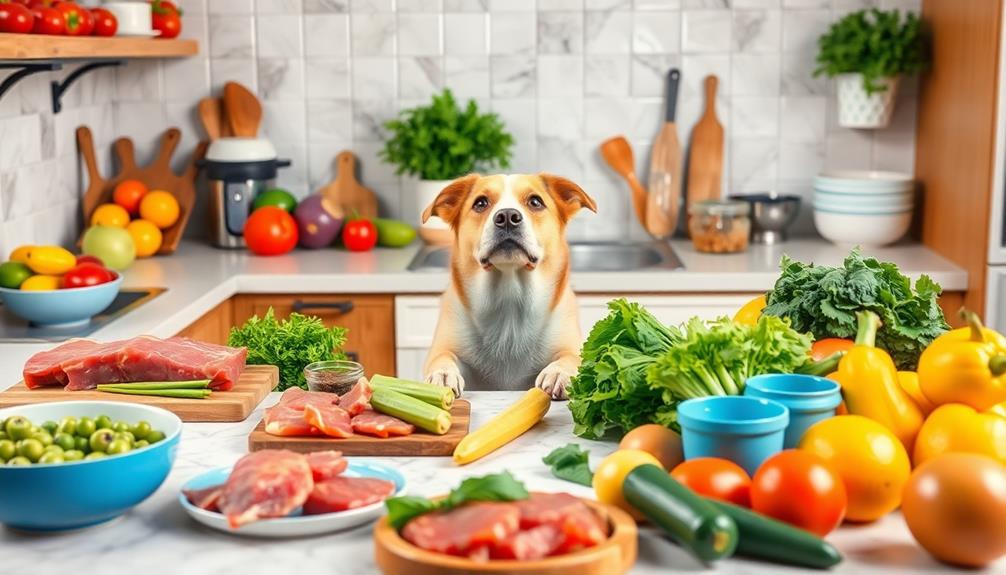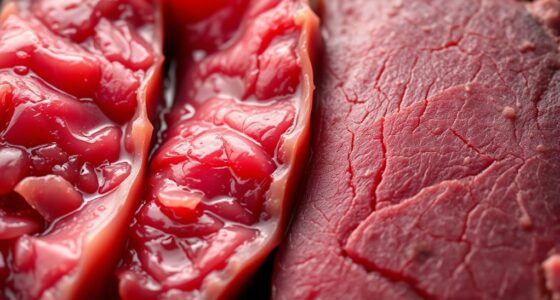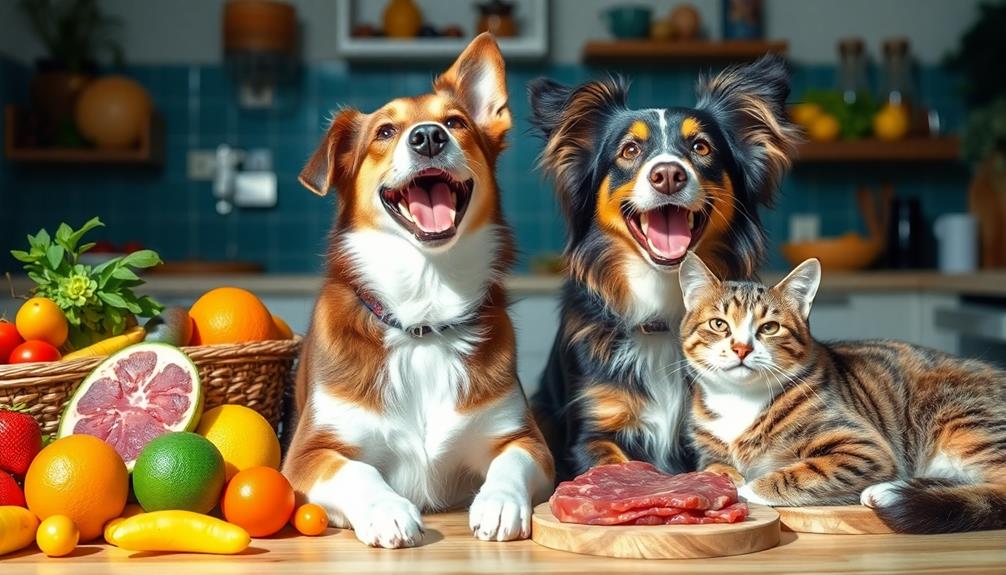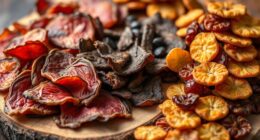When managing a raw food diet for multiple pets, start by gradually shifting them to the new food. Mix small amounts of raw food with their current meals and increase the raw proportion over weeks. Keep a consistent feeding schedule and feed pets in separate areas to avoid competition. Prioritize hygiene by washing your hands and using separate utensils for raw food. Monitor each pet's response to confirm they're getting a balanced diet rich in nutrients. For more tips on achieving the right balance and guaranteeing safety, you'll find valuable insights below.
Key Takeaways
- Establish a consistent feeding schedule for each pet to promote stability and reduce competition during mealtime.
- Feed pets in separate areas to prevent resource guarding and ensure each pet gets its appropriate portion.
- Monitor portion sizes based on each pet's body weight and activity level to maintain a balanced diet.
- Use meal prep containers to organize and manage individual diets efficiently, preventing food mix-ups.
- Consult a veterinarian for tailored nutritional guidance to ensure all pets receive balanced and adequate nutrition.
Benefits of Raw Food Diet
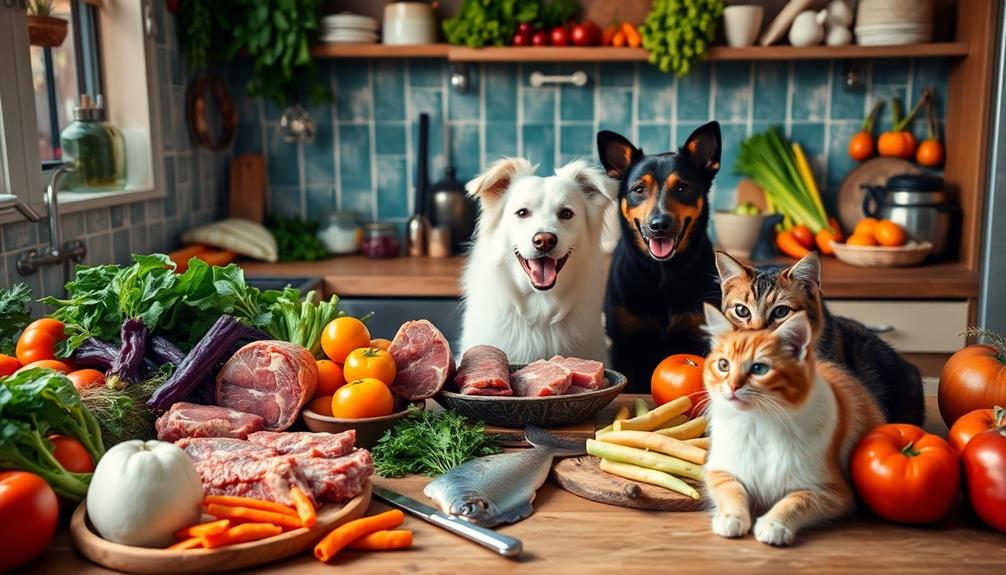
When you consider the benefits of a raw food diet for your pets, you'll find it closely mirrors the natural eating habits of their wild ancestors, which can lead to improved health and energy. This diet is rich in protein and essential amino acids, promoting healthy muscle mass and bolstering your pet's immune system.
By providing a balanced raw food diet, you're ensuring your pets receive ideal nutrition that supports their overall well-being.
Another significant advantage is the high moisture content found in raw foods, which aids in hydration and contributes to digestive efficiency. Many commercial diets can be high in carbohydrates, but a raw food diet is typically low in carbs, making it perfect for pets dealing with obesity or diabetes.
Ultimately, feeding a species-appropriate raw diet can enhance your pets' longevity and health, allowing them to enjoy a better quality of life.
With these benefits in mind, you can see how shifting to a raw food diet can lead to healthier, happier pets. Embracing this natural approach aligns closely with their instincts and dietary needs, ensuring they thrive in your care.
Transitioning to Raw Diet
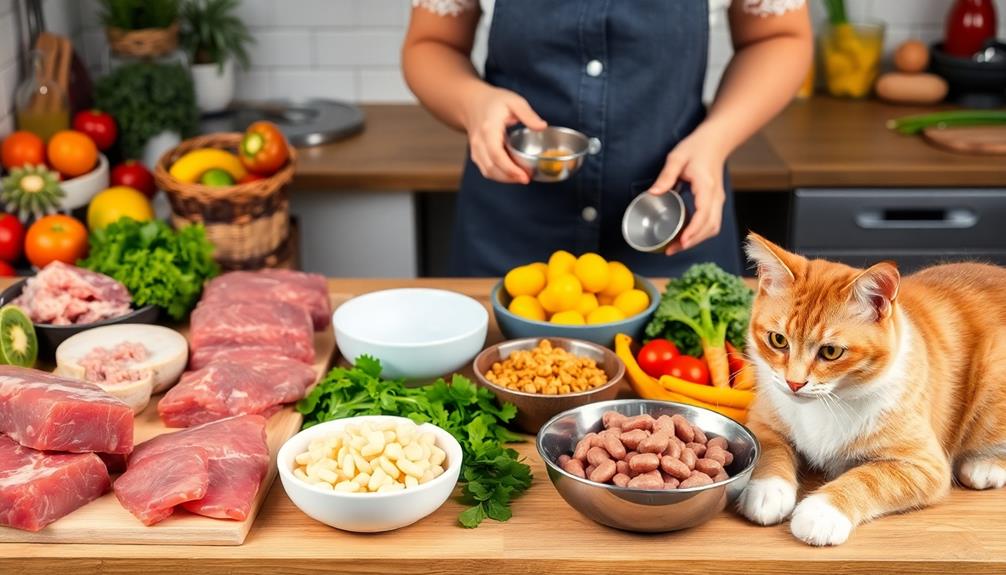
Changing your pets to a raw diet can be a rewarding journey if approached thoughtfully. Start shifting to raw diets by mixing small amounts of raw food with their current meals. This helps them acclimate without facing digestive issues. You should gradually increase the amount over several weeks. Healthy dogs usually adapt within a week, while cats may need a bit longer.
For pets with digestive sensitivities, a very gradual shift is vital. You might want to lightly cook the food before introducing raw options. Monitoring each pet's response during this process is important, as their health can dictate the shift's length and method.
Consulting with a veterinarian or a veterinary nutritionist can offer tailored guidance to guarantee balanced nutrition for all pets. Here's a quick overview of the shift process:
| Shift Steps | Details |
|---|---|
| Start Slowly | Mix raw food with current diet |
| Gradual Increase | Increase raw food proportion weekly |
| Monitor Responses | Watch for digestive issues or sensitivities |
Managing Feeding Schedules
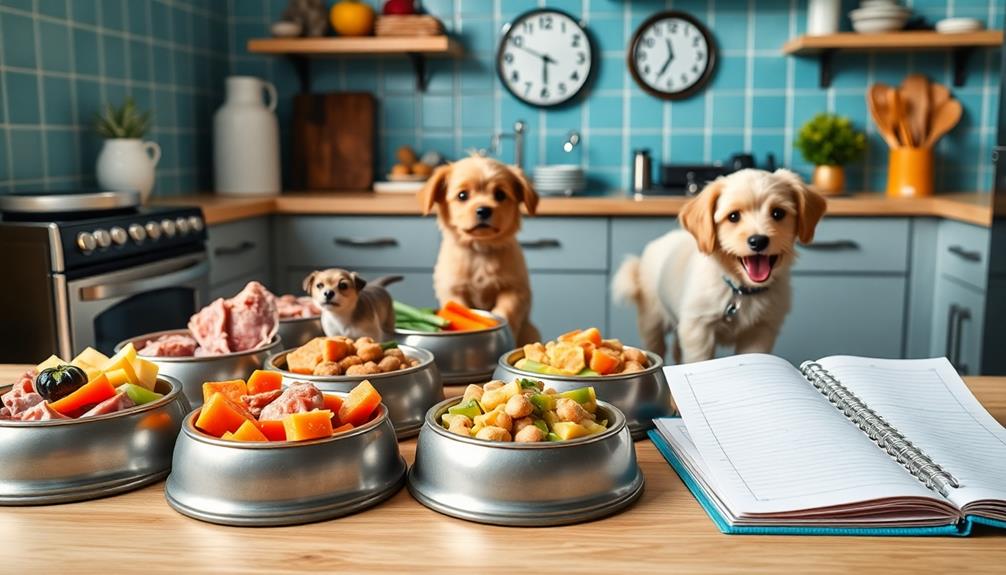
Establishing a consistent feeding schedule for your pets is crucial for their well-being. Aim to feed them at the same times each day, as this routine promotes stability and reduces anxiety.
With multiple pets, consider feeding them in separate areas to prevent competition and guarantee each one gets their appropriate portion of raw food.
Monitor portion sizes based on each pet's body weight and activity level. Generally, you'll want to feed 2-3% of their ideal body weight daily, dividing it into two meals.
Using meal prep containers can help you manage their diets effectively, making it easier to avoid overfeeding or underfeeding.
Adjust feeding times according to each pet's unique dietary needs. For instance, if you're mixing raw diets with kibble, separate their meals to optimize digestion and nutrient absorption.
This tailored approach guarantees all your pets are getting the right nutrition while accommodating their individual requirements.
Safety and Hygiene Practices
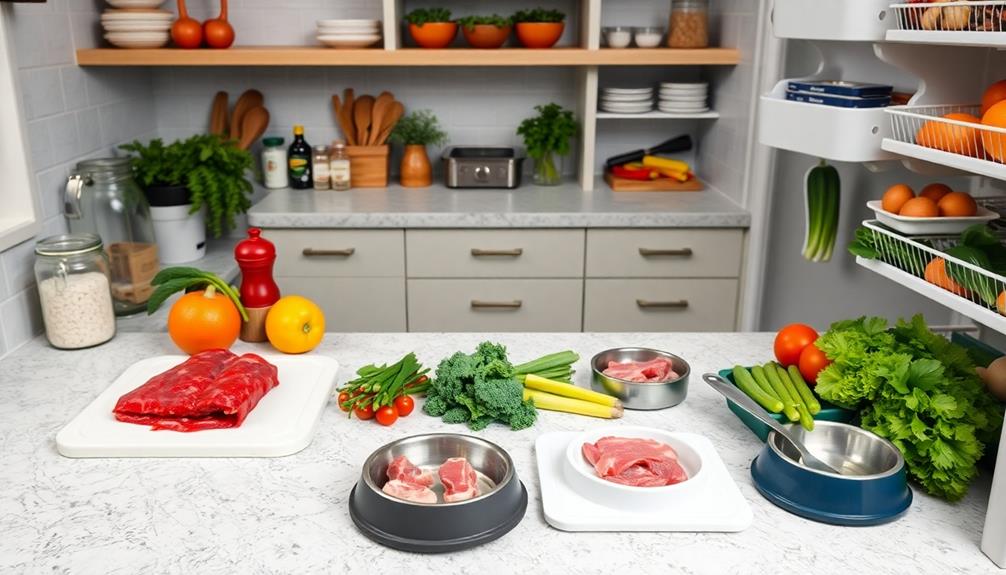
Maintaining proper safety and hygiene practices is fundamental for preventing health risks associated with a raw food diet for pets. Start by washing your hands thoroughly with soap and water after handling raw pet food. This helps eliminate harmful bacteria like Salmonella and E. coli.
During raw food preparation, always use separate cutting boards and utensils to avoid cross-contamination with human food. Additionally, consider incorporating high-quality protein sources, similar to those found in best dog food for allergies, to guarantee your pets receive ideal nutrition.
When it comes to storage, keep raw pet food in airtight containers and store it in the freezer or refrigerator at the appropriate temperatures. This not only maintains freshness but also reduces bacterial growth.
After preparing raw food, make it a priority to clean and sanitize all surfaces and equipment immediately. This step is critical for eliminating any lingering pathogens.
Additionally, monitor your pets for signs of gastrointestinal distress, such as diarrhea or vomiting. These symptoms can indicate bacterial contamination or food intolerance, and addressing them promptly is essential for their well-being.
Nutritional Considerations for Pets

Understanding the nutritional needs of your pets is vital when adopting a raw food diet. A balanced raw diet requires the right proportions of muscle meat, bones, and organ meats, mimicking the whole animal consumption of wild canines.
Homemade raw diets can easily lack necessary nutrients unless you carefully formulate them, so consulting with a veterinary nutritionist is important to avoid deficiencies.
To achieve nutritional completeness, incorporate a variety of protein sources and guarantee organ meats are included several times a week. It's important to provide adequate fat, fiber, vitamins, and minerals tailored to each pet's specific dietary needs, especially in a multi-pet household where requirements may vary.
Regularly evaluate each pet's individual health and dietary response to maintain the nutritional balance of their raw food diet. This careful monitoring will help you identify any adjustments needed to keep your pets thriving.
Frequently Asked Questions
How Do You Feed Multiple Pets?
When you feed multiple pets, set up separate feeding areas to avoid competition. Use measuring cups for accurate portions, monitor their eating habits, and rotate food sources for variety and balanced nutrition tailored to each pet's needs.
How to Balance a Raw Diet for Dogs?
To hit the nail on the head, balance your dog's raw diet by mixing muscle meat, bones, and organs. Adjust portions based on weight and activity, ensuring variety for ideal nutrition and health monitoring.
What Is the Best Raw Food Ratio for Dogs?
The best raw food ratio for dogs is generally 2-3% of their ideal body weight daily. Adjust this based on your dog's activity level, age, and health to guarantee they maintain a healthy weight.
How Do I Bulk Raw Dog Food?
Did you know that over 60% of dog owners struggle with meal prep? To bulk raw dog food, prepare large batches using a mix of meats, store portions in the freezer, and consult a vet for balanced nutrition.
Conclusion
Switching your pets to a raw food diet can be a game-changer for their health, but it's essential to do it right. You might wonder if raw diets really improve pets' energy and coat quality. The truth? Many pet owners swear by the transformation they see. By following proper management tips and ensuring safety, you can give your furry friends the best nutrition possible. Why not take the plunge and see the benefits for yourself?

